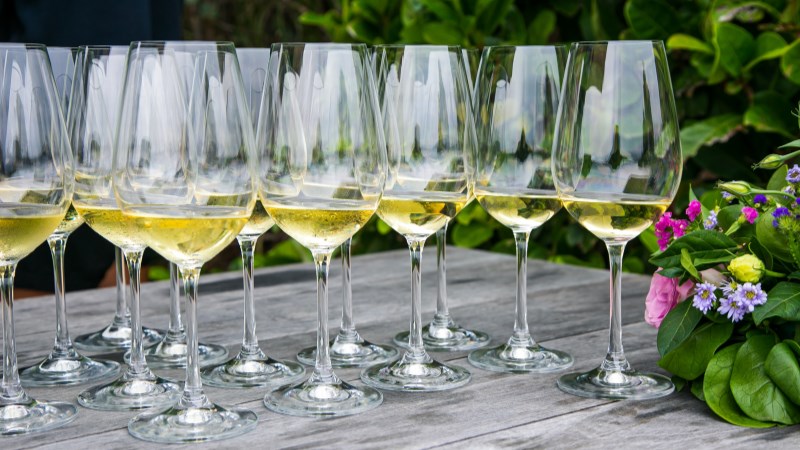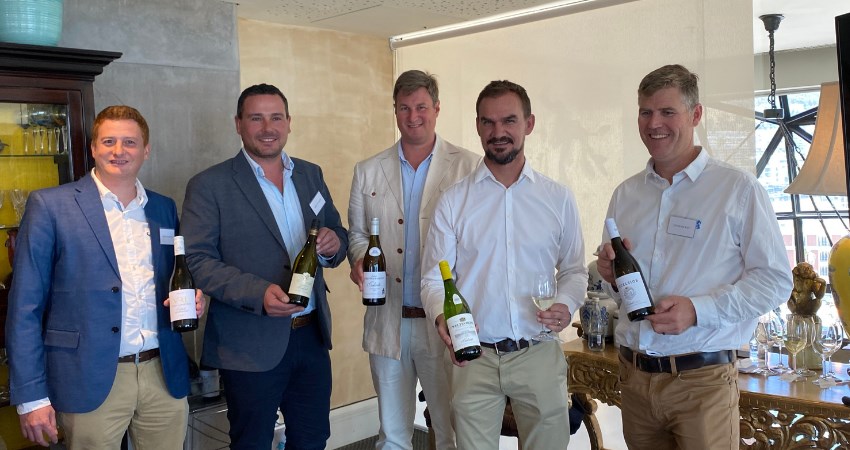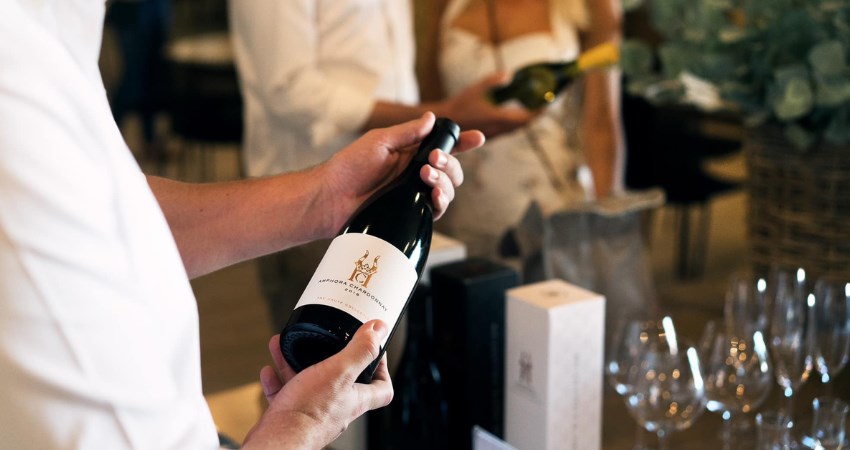Sauvignon showcase
The year began and ended with Sauvignon Blanc, South Africa’s top-selling variety. Convened in South Africa for the first time, the fourteenth annual Concours Mondial du Sauvignon held in March 2023, was an international showcase for Sauvignon Blanc SA. Attending a trio of tastings which showcased the styles of Sauvignon Blanc made in Constantia, Durbanville and Franschhoek was a learning curve in terroir and the versatility of the variety for judges, critics and writers alike.
The highlight of Concours Mondial was the tasting at Groot Constantia where nine leading producers showcased the diversity of cool-climate expressions of Sauvignon Blanc in the historic valley which specialises in the variety.
The Concours showcase of twenty Sauvignon Blancs in Durbanville Wine Valley, another region where Sauvignon rules as the signature variety, was another highlight of the year. Thirteen top producers showed the versatility, styles and terroir of Sauvignon Blancs from De Grendel, Diemersdal and De Grendel to Meerendal and Durbanville Hills, which hosted the event.

Counting roots
In late November, Thys Louw hosted a global tasting of Sauvignon Blanc at Diemersdal, the family winery in the Durbanville Wine Valley which sets the bar for the variety. The sixth-generation family farm specialises in six different styles of Sauvignon from their dryland vineyards, handling over 2500 tons of the hero variety in the cellar. The opportunity to taste Diemersdal Sauvignon Blanc in a benchmark line-up of legendary wines from Sancerre and Bordeaux to Austria (next year’s host of Concours Mondial du Sauvignon) was one of the top tastings of the year – paired to a sumptuous seafood feast of freshly caught perlemoen, galjoen and salmon prepared by the Louw matriarchs.
You’re never too old to learn a new trick in the wine trade. Over a tasting of Domaine Didier Dagueneau Silex 2019, one of the most famous Sauvignon Blancs in the world, Thys spoke about how all the top wines in the world are dryland.
I heard for the first time how some French winemakers prune the fine roots of vines in the sub-soil to encourage deep roots in these old fossil soils, and try to calculate the hundreds of thousands of roots found in one hectare of vineyards in the Sancerre. Diemersdal’s The Journal Sauvignon Blanc, sourced from 30 year-old vines, is Thys’ ode to Sancerre.
Kings of Calcrete
Talking of ancient soils, the long-awaited launch of the Calcrete Collective by six leading winemakers of Chardonnay from the Robertson Wine Valley in October was another highlight of the year. The big reveal of the new Chardonnay brand and appellation pioneered by Philip Jonker of Weltevrede took place appropriately at the Wisdom Room at the Silo Hotel on the Cape Town Waterfront. Arguably the first initiative of its kind in the new world, Calcrete Chardonnay – branded on six new Chardonnay labels of Weltevrede, De Wetshof, Rietvallei, Excelsior, Van Loveren, and Bon Courage – derives from the unwooded style of Chardonnay grown in limestone rich, calcrete soils, and terroir.
Human terroir was one of the big buzzwords of the year, adding to the matrix of soil, climate, and site. In presenting the new Chardonnay vintage of 2023, the kings of Calcrete (officially called the "Calcrete Custodians") spoke of tapping into the accumulated wisdom and deep roots of generations of winemakers on the old family wine farms of the Robertson Wine Valley.
Philip Jonker spoke about how they want to build the new brand of Calcrete Chardonnay not by the name of the cultivar but by the style of the wine which expresses the terroir in its purest form. "Allow the soil to speak" is his mantra. The calcium in the soil derived from ancient maritime fossils builds the flavours of the Chardonnay – as in its home in distant Chablis.
Over a fascinating tasting of six Calcrete Chardonnays from Robertson, the five winemakers described the essence of the style that best expresses the “new old” brand – the luminous lime-green tones, the steely oyster shell minerality, the lean texture, saline qualityand flinty, wet pebble flavours. Chardonnay, the hero variety of the Robertson Wine Valley, the source of many top Cap Classique, is entering a new era. The Roman emperor Hadrian said wines unlock the volcanic mysteries of the soil. A contemporary local geologist says wines unlock the eons of memory in soil. Watch this space.

Chardy masterclass
The annual release of six styles of Chardonnay by De Wetshof has grown into another major event on the annual tasting calendar. Johann de Wet’s annual lecture on the state of Chardonnay is a showpiece for the variety – and not to be missed. The home of one of the first Chardonnay wines made in South Africa in the early 1980s, grown from smuggled vines, De Wetshof and the Robertson Wine Valley are two of the rock stars of South African wine exports and domestic consumption today.
De Wetshof is famous for its clonal nursery of Chardonnay today – and for developing its own clones. The release of their new Calcrete Chardonnay 2023 extends their range of Chardonnay to six wooded and unwooded styles, including the iconic Limestone Hill, Bon Vallon, Finesse, The Site and Bateleur. Johann describes the new Calcrete Chardonnay as a fingerprint style for the area, "an appellation initiative" – a textbook Robertson Chardonnay made in a lean, elegant, mineral, saline style. He believes that soil has a much bigger effect on wine than clone – and that the ideal vineyard is a mix of clones to avoid one-dimensional wines.
Johan says, "Chardonnay in one vineyard can have a totally different personality to the one next-door. Chardonnay is a real chameleon – it’’s not made to a recipe. Fashion tends to drive your wine style. Twenty years ago consumers wanted fat buttery wooded Chardonnay – not unwooded."
The First Estates
Another landmark event on the tasting circuit in 2023 was the fiftieth anniversary of the first fourteen wine estates in the Cape – registered under new wine regulations passed in August 1973. The original members – Alto, Backsberg, Groot Constantia, De Waal, Meerendal, Middelvlei, Muratie, Neethlinghsof, Overgaauw, Simonsig, Theuniskraal, Twee JongeGezellen and Verdun (Asara) – got together at Groot Constantia for a memorable tasting of vintages back to 1973 – and a lively debate over the evolution of changing estate definitions and legislation over the decades since.
The old wine of origin (WO) system – symbolised by three bands on the neck of a wine bottle (blue for appellation, red for vintage, green for variety) – in gold if deemed a "superior wine", carried the estate (or landgoed) logo if it qualified under the new scheme. Originally, the grapes weremostly grown, vinified and bottled on a farm with contiguous vineyards. I always feel a tinge of nostalgia when I find one of those old bottles carrying what became fondly known as "the bus ticket". The rules were eased as the number of registered estates grew to over a hundred – and many began buying grapes and vineyards in other areas to produce high-volume brands, especially for export.
While the original concept of estate wine has been diluted over the years, the pursuit of authenticity and traceability of terroir has continued in recent decades in new forms via certification of single vineyard wines and old vine wines. Bennie Howard of Meerendal, an industry veteran, described the estate scheme as "one of the finest examples of traceability in the world." The debate of the year.
New wine, old vessels
If the focus on variety was one of the themes of 2023, innovations in winemaking techniques – especially the use of amphora, cement eggs and qvevri – was another key theme at tastings. Winemakers at key tastings of reserve wines by Haute Cabrière, Kleine Zalze and KWV The Mentors demonstrated their pursuit of purity by going back to ancient wine vessels made from clay and terracotta soils such as amphorae – wines which express the terroir.
Takuan von Arnim and Tim Hook of Haute Cabrière in Franschhoek unveiled their new Haute Collection of limited site-specific wine which showcase alternate varieties, winemaking methods and styles. Labelled in wax-sealed bottles, the Amphora Chardonnay and Amphora Semillon – signifying the comeback of what was once punted as the signature variety of the Franschhoek Wine Valley – celebrate innovation. The white wines in the new collection are either 100% amphora or combine three components of a multi-layered wine fermented in amphora, concrete eggs and oak using a special organic native yeast. The wines are highly textured and express great purity of fruit.

A-Z of amphora
RJ Botha, cellarmaster of Kleine Zalze, also did a big reveal of the cellar’s premium Z collection of alternate varieties, made using amphora to see how future wines might perform in their top family reserve tier. "We wanted to see how wines fermented and aged in amphora would age in the bottle," he says.
Since the 2022 vintage, they’ve combined wine made in both concrete eggs and terracotta amphora to build complexity and texture in the wines. He says that amphora are anti-oxidative and anti-microbial, producing a clean and pure wine with crystallised lees; while eggs encourage "wines with attitude" and a textural base. "How do we keep freshness in the wine?" he ponders.
With varieties such as Chenin Blanc, Riesling (Elgin), Cinsault, Grenache and Syrah in the Z range, part whole-bunch, part egg and part oak-matured, the tasting was a tour-de-force. The biggest buyer of old vine Chenin Blanc in South Africa, Kleine Zalze aims to keep old vines alive and profitable – and is currently experimenting with alternate varieties such as Alvarinho and Verdelho for future vintages.
Alternate varieties
Talking of alternate varieties, winemaker Izele van Blerk led a fascinating tasting of The Mentors range of wines – including a new Nebbiolo release. Highlighting the fact that Barolo, one of the most expensive vineyards in its native Italy, needs three years in barrel and two years in bottle, KWV has just released a maiden 2017 vintage which will age for ten years. “These tannin bombs with high acidity look like Pinot Noir and taste like Cabernet Sauvignon.” It joins a Mentors range renowned for experimenting with niche varieties such as Carménère, Carignan, Grenache Blanc, and Petit Verdot.
The degustation menu at Dusk, the new fine dining restaurant in downtown Stellenbosch, was the food and wine pairing of the year. Showcasing eight of the KWV Mentors range, including the acclaimed Canvas (Rhone-style blend) and Orchestra (Bordeaux). Izele emphasised, "We wanted to include Pinotage and Chenin Blanc in the premium Mentors range to show what South African can do. You learn to understand these varieties and work with nature in the vineyards. Express the purity of fruit. Don’t overwork the grapes and tannins."
US oak works particularly well with Pinotage and Shiraz. A decade ago, I tasted barrel components of the future Mentors range at KWV – and walked in the KWV nursery vineyard to see the exciting new varieties now coming to fruition in the cellar.
Riesling rendezvous
Riesling tastings don’t come around too often. I can recall attending three in the last three decades – one in the Mosel in Germany, one at Paul Cluver in Elgin, and one at Aubergine in Cape Town. While afficionados and critics predict the comeback of Riesling, the holy grail remains out of reach. So when Delheim launched its new Staying Alive Riesling 2022 at Elgrin March 2023 – in a line-up with a handful of top-flight German Riesling made in the newer, contemporary style, we went to town.
Delheim Wine Estate has excelled with its signature five-star Edelspatz Noble Late Harvest dessert wine. Christoph Hammel, the ninth-generation winemaker at Hammel Wine Estate (1723) in Germany, co-made their new Riesling with Delheim winemaker Roelof Lotriet.
Hipster Hammel is forthright on the revival of Riesling: "The modern German style of Riesling is clean, dry, fresh, lively and fruit-driven. I want it to taste like the grape off the vine. Younger consumers want fruit-driven wine with minerality. There’s a lot of potential for Riesling in South Africa."
Hammel talks about "the precision, stretchability and versatility" of Riesling. He used lots of skin contact, concrete eggs and acacia barrels to make Delheim’s Staying Alive Riesling 2022. Definitely a top ten tasting in my notebook.